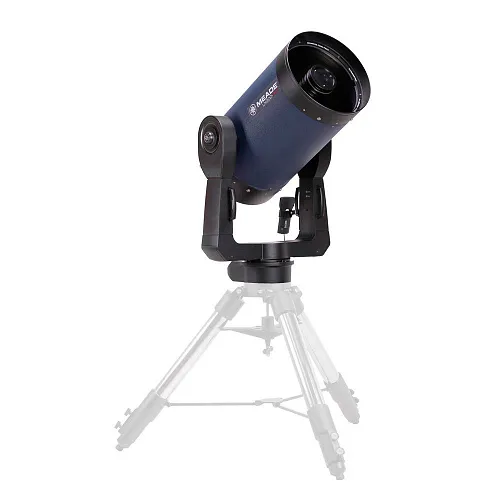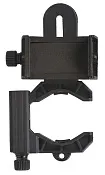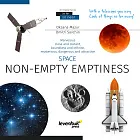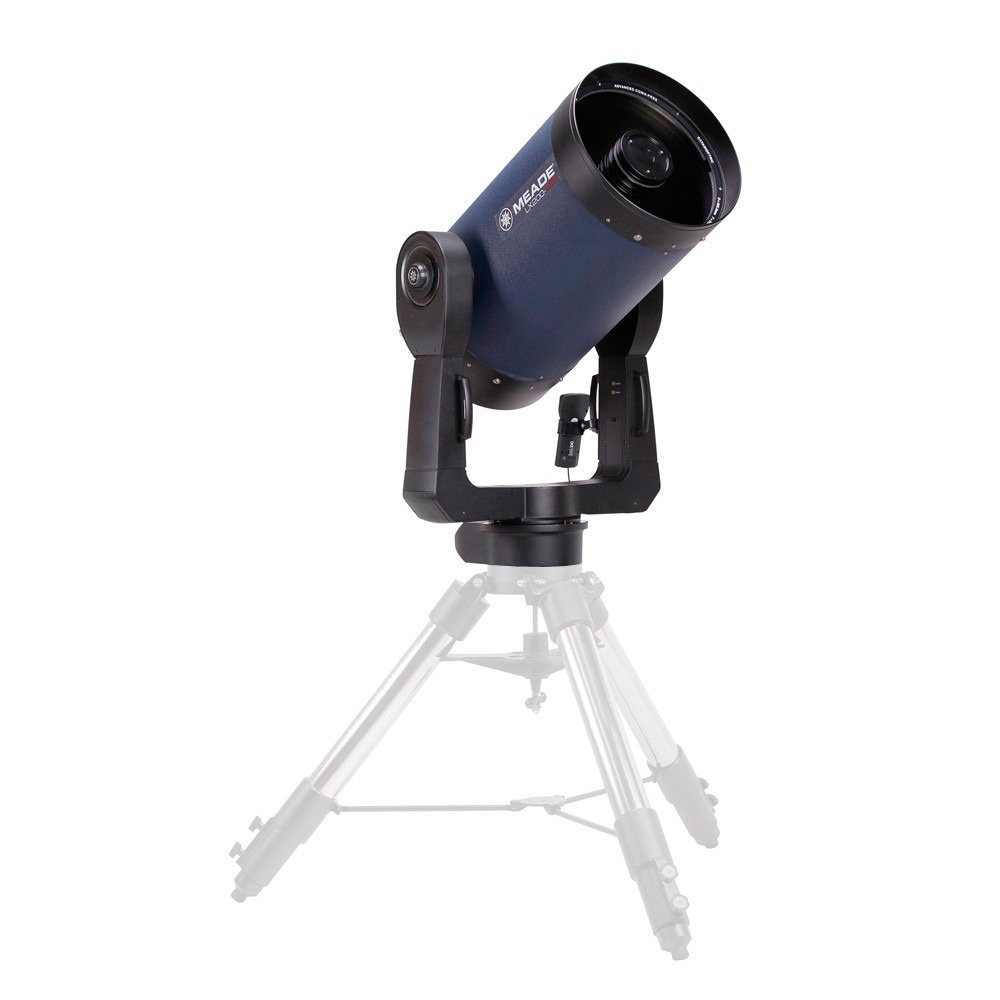Meade LX200 14" F/10 ACF Telescope without Tripod
Advanced Coma-Free telescope with GoTo function. Objective lens diameter: 356mm. Focal length: 3556mm
| Product ID | 71718 |
| Brand | Meade Instruments Corp. |
| Warranty | 2 years |
| EAN | 0643824209237 |
| Package size (LxWxH) | 81x58x134 cm |
| Shipping Weight | 72.64 kg |
This 14" LX200-ACF has 14" diameter f/10 ACF optics (focal length 3556mm) and Ultra-High Transmission Coatings (UHTC) for maximum image brightness and contrast. Features the advanced LX200 AutoStar II computer system with 145,000 object library, multiple guided tours, high precision pointing capability with sub arc-minute pointing accuracy, and Meade smartdrive with permanent periodic error correction.
Precise and quick star alignment is done near effortlessly with Meade's level north technology alignment system incorporating a 16 channel GPS receiver. The Autostar II is flash-updatable via free downloads at Meade.com (optional cable required). The drive base of the telescope has multiple input and output ports including an RS-232 PC interface and jacks for a (user supplied) CCD Autoguider and illuminated reticle.
Mechanically loaded as well all LX200 models feature a primary mirror locking mechanism, which effectively prevents movement of the primary mirror during long exposure astrophotography or observing. Turn the lock knob located just above the telescopes main focus knob and the progressive-tension primary lock completely cancels any residual image shift due to mirror movement during visual, photographic, or imaging applications.
All LX200-ACF models feature the DC-servo driven super heavy duty double fork mount, the strongest and most rigid mount in its class. Fast slew speeds are from 1º to 8º per second, and can be user selected at .1º per second increments, while fine slewing and photographic guiding speeds can be adjusted from .01x to 1x sidereal in one one-hundredth increments. The mount and all electronics are internally powered by 8 (user supplied) C-cell batteries which will typically operate the telescope for around 20 hours. The mount additionally has mechanical locks and slow motion manual controls in both axis if for some reason you found yourself without power.
The 14" LX200-ACF comes fully equipped with 1.25" diagonal mirror, Series 4000 26mm Plössl eyepiece, 8x50 viewfinder with quick release bracket and Meade AutoStar Suite Astronomer Edition Software for PC. Scope weight is 56.7kg.
Sold without tripod, ready for your custom pier or mounting.
Features:
- 14" f/10 Advanced Coma Free Optics – 3556mm focal length
- Ultra-High Transmission Coatings (UHTC)
- AutoStar II GoTo system
| Product ID | 71718 |
| Brand | Meade Instruments Corp. |
| Warranty | 2 years |
| EAN | 0643824209237 |
| Package size (LxWxH) | 81x58x134 cm |
| Shipping Weight | 72.64 kg |
| Optical design | catadioptric |
| Optical scheme | coma-free Schmidt–Cassegrain |
| Optics material | main mirror: Pyrex |
| Optics coating | UHTC |
| Objective lens diameter (aperture), mm | 356 |
| Focal length, mm | 3556 |
| Lowest practical power, x | 60 |
| Highest practical power, x | 850 |
| Aperture ratio | f/10 |
| Resolution threshold, arcseconds | 0.326 |
| Limiting stellar magnitude | 15.2 |
| Image scale in focus, °/cm | 0.157 |
| Focusing | coarse: by moving the main mirror; fine: by moving the eyepiece along the optical axis |
| Eyepieces | SUPER Plössl 26mm (136x) Series 4000 |
| Eyepiece barrel diameter, in | 1.25 |
| Finderscope | optical, 8x50 |
| Telescope control | autoguide |
| Mount | alt-azimuth, fork, dual arm |
| GPS receiver | integrated |
| Drive | DC drives along both axes |
| Additional | 90 ° diagonal mirror (1.25") |
| Slew rate | along both axes: from 0.01x x to 1x in increments of 0.01x; 2x, 8х, 16x, 64х, 128x; 1 degree to 2 degrees per second in increments of 0.1 ° |
| Tracking rate | Lunar, customizable, sidereal |
| Positioning accuracy | up to 1 arcminute |
| Tracking mode | automatic (StarLock) |
| Input date and time | ✓ |
| Ports | AUX, AutoStar remote control connector, RS-232 (2 pcs.) |
| Autoguider | ✓ |
| Hand controller | Autostar II |
| Objects database | 145,000 |
| Ability to connect additional equipment | camera via adapter and bayonet ring (purchased separately) |
| Power supply | 12V DC (optional), 8 C batteries, Meade uninterruptible power supply (optional) |
| User level | experienced users, professionals |
| Assembly and installation difficulty level | easy |
| Observed object | planets of the Solar System and deep-sky objects, terrestrial objects |
and downloads
Convenient diagrams that describe how to install additional accessories on refractors and catadioptric telescopes
Find out how to assemble a telescope on an example of the Levenhuk Skyline 90x900 EQ telescope
This short guide will help you avoid typical mistakes and learn more about telescope and mounting types
The basics of astronomical observations for beginners
In this article we have gathered answers to some of the most frequently asked questions about telescopes
How telescopes work?
You can actually perform observations from your balcony!
All about telescope sizes, types, magnification, and mounts
Learn how to set up and use the telescope properly
Astronomy in light-polluted skies. Find out what you can observe in the city
Read an interesting comprehensive article on telescopes for little astronomers
Celestial objects you can observe with telescopes of different apertures
Colored and vivid images of galaxies, planets and star clusters entrance everyone who is fascinated by boundless space
Find an interesting review on the history of the changes to a refracting telescope
To make the process of choosing a telescope easier, we will tell you about the characteristics of the most popular types of telescopes today
Learn everything you need to know about refractor telescopes to make the right choice






